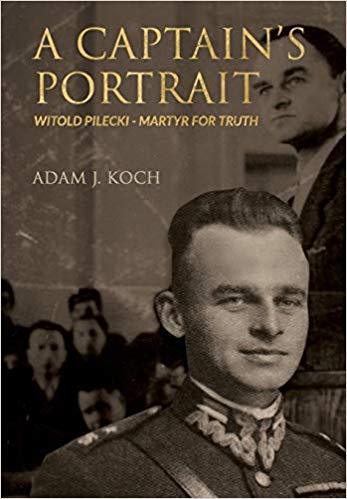Witold Pilecki And His Mission Koch

A Captain’s Portrait, by Adam J. Koch. 2018
A Comprehensive Work on the Life and Heroism of Witold Pilecki
This book begins with an overview of Polish history before moving to the main subject. Now, Pilecki is best remembered for surviving Auschwitz, and for being tortured and murdered by the Soviet-imposed Communist authorities, but his public life goes much beyond that. He fought in the 1920 Polish-Bolshevik war. He was friends with Smigly-Rydz, and later took part in combat in the 1939 Polish Defensive War. Author Adam J. Koch debunks the myth that there was nothing that France and Britain could have done for Poland in 1939. In fact, the French and British had a 5:1 advantage over the German forces stationed in western Germany in September 1939. (p. 160). Pilecki also was in the Polish Underground, and fought in the ill-fated Soviet-betrayed Warsaw Uprising.
Every imaginable detail is presented about Pilecki. For instance, he was an animal lover, and opposed unnecessary suffering for animals. (pp. 146-147).
BLACKMAILERS CAN BE FOUND ANYWHERE, AND NOT ONLY POLES ACTING AGAINST JEWS!
Much has been said about the Polish SZMALCOWNIKI, who extorted money from fugitive Jews. Pilecki’s experience, after the 1939 War, reminds is that never-do-well Poles also acted against other Poles, but we never hear about that. Pilecki hired a smuggler to transfer him to the German-occupied zone. The smuggler took the money, but left the Pilecki family stranded in the Soviet-occupied zone. (pp. 174-175).
POLES WERE GENOCIDALLY TARGETED, AND NOT ONLY FOR OFFERING RESISTANCE
The Germans were not merely interested in suppressing Polish resistance: They wanted to destroy the Polish people, beginning with the intelligentsia. For instance, priests and judges, arriving at Auschwitz, were often summarily killed. (p. 188).
POLES AND RUSSIANS WERE ALSO GASSED AT AUSCHWITZ, AND NOT ONLY JEWS
Until early 1942, most of the prisoners at Auschwitz were Poles. (p. 181). The later mass gassing operations at Auschwitz were not limited to Jews. They included Poles, notably from Operation Zamosc. In a June 1943 report quoted by Koch, Pilecki writes, “It caused us a particularly great pain when in enormous piles of clothes and things left by the gassed people we could find children’s little shoes and prams, also rosaries and Polish prayer books. Among others killed in this horrific slaughter there also were people from a few villages from the Lublin province.” (pp. 251-252).
LAST-MINUTE NAZI KILLINGS—AND NOT ONLY OF JEWS
In the last days of the Third Reich in 1945, some (but far from all) Jews were killed. However, so were many non-Jews. Pilecki was a POW at Murnau. The SS Commander was killed in a combat encounter with American forces. In his pocket was found an order to kill every single Murnau POW. (p. 338).
THE SECOND SOVIET OCCUPATION OF POLAND
Poland exchanged one master for another. The sham elections, of January 1947, that officially brought the Communists to power, had earlier included the purging of 400,000 voters thought likely to oppose Communism. (p. 352). A report that accused Pilecki of plotting the assassination of top Communist officials was a hoax planted by the MBP. (pp. 350-351). Pilecki was heinously tortured and murdered. During 1944-1956, the Communists murdered 2,450 Poles in judicial trials along with about 15,000 without even the formality of a trial. Another 150,000 Poles were jailed. Approximately 100,000 members of the A. K. (ARMIA KRAJOWA) were sent to the Gulags. In short, at least a quarter million Poles faced direct Communist terror. (pp. 372-373).
CULTURAL MARXISM, LIKE THE CONVENTIONAL MARXISM THAT PRECEDED IT, IS HOSTILE TO POLISH PATRIOTIC AND RELIGIOUS TRADITIONS
This is the legacy of Witold Pilecki: In the Foreward, Professor Tracey Rowland of the University of Notre Dame in Australia, comments, “In the 21st century Poland is yet again under attack, this time from proponents of a totalitarian liberalism, many of them highly placed within the bureaucracies of the European Union. To achieve their aims they want to suppress the history of Polish heroism and of the staunch defence of the Catholic faith underlying Poland’s traditional culture.” (p. xi).
To see a series of truncated reviews in a Category click on that Category:
- All reviews
- Anti-Christian Tendencies
- Anti-Polish Trends
- Censorship on Poles and Jews
- Communization of Poland
- Cultural Marxism
- German Guilt Dilution
- Holocaust Industry
- Interwar Polish-Jewish Relations
- Jewish Collaboration
- Jewish Economic Dominance
- Jews Antagonize Poland
- Jews Not Faultless
- Jews' Holocaust Dominates
- Jews' Holocaust Non-Special
- Nazi Crimes and Communist Crimes Were Equal
- Opinion-Forming Anti-Polonism
- Pogrom Mongering
- Poland in World War II
- Polish Jew-Rescue Ingratitude
- Polish Nationalism
- Polish Non-Complicity
- Polish-Ukrainian Relations
- Polokaust
- Premodern Poland
- Recent Polish-Jewish Relations
- The Decadent West
- The Jew as Other
- Understanding Nazi Germany
- Why Jews a "Problem"
- Zydokomuna